Medieval Dynasty — Beautiful game, but needs more.
Medieval Dynasty‘s promise is in its title: start from nothing to build your own dynasty and see it survive the test of time. It’s not a task that you’ll see evolve quickly. It’s the effort you put into building your legacy year after year that will see it grow into something fit for your descendants, when you meet your inevitable demise. It’s a formula that publisher Toplitz Productions seems to be banking on, given they’re simultaneously working on Lumberjack’s Dynasty, Farmer’s Dynasty and Wild West Dynasty. It is a game full of potential, and its stint in early access will decide how much of that potential it can realise.
A caveat before the next few paragraphs of explanation: Medieval Dynasties is a good game, fun for many, just not for everyone in its current incarnation. This is something we need to address before going any further:
Do not go into Medieval Dynasties expecting to find a city builder. It is not. Leave any expectations in that regard at the door.
First and foremost, Medieval Dynasties is a survival game with roleplaying, building and management elements. Its roleplaying elements are there, but they bring nothing beyond the ordinary to the table. Fetch quests are its bread and butter, at this time in early access. You can build, for certain, but it is impossible to build on anything steeper than a slight incline, which dashes any hopes you might have of a settlement approaching reality. If humanity hadn’t learned to deal with hills, we wouldn’t have to worry about leaving our cars parked in gear. But the survival mechanics are all there, with personal grind and grift the key to early survival and later smooth running.
Start from humble beginnings

You begin your dynastic journey with the medieval equivalent of a golden ticket: free license to build wherever you want, hunt whatever you want and take whatever resources you want from the local area. As long as you pay taxes, of course, but hey, nothing in life is free. You have one quest: build a house. This means setting out with nothing but the clothes on your back, the dried meat stuffed in your pockets and a handful of spare change. Since thirst is a major concern, you’ll need to find somewhere to build near water. If you’re planning further ahead, you’ll want to make sure there are enough resources nearby
We picked a location fairly close by, though it proved frustratingly far from some resources later on. If we’d travelled further, we would have had to pay closer attention to our stats. Hunger and thirst build faster than you might expect. Racimir is a racing monolith of a man quite capable of gobbling more than one whole deer per day/night cycle. It makes sense if you think of it along the lines of condensed time, where each cycle is equivalent to a month or so in reality.
That initial burst of exploration showed us how gorgeous the game can be. Medieval Dynasty’s scenery cycles between the seasons, from the full greens and berry-laden bushes of summer to the empty branches and white canvas of winter. Within that, the villages sit, distinctly different depending on the material used to construct them. The soundtrack is quite enjoyable as well, though one of the tracks sounds better suited to combat than casual exploration.
Build a new home

With your location selected and your stomach full, you come to building. For this, you need tools, and that’s where your familiar survival loop comes into play. Some sticks and stones net you an axe, and chopping down some trees will let you craft a hammer from the crafting wheel. It’s all fairly intuitive and watching trees topple when you’ve cut them through is satisfying. Thankfully no one’s complained about having them fall on their houses yet. My one complaint here is that stones are ridiculously hard to spot against the ground texture and undergrowth. There are a lot of small-to-medium-sized stones that look as though you should be able to pick them up, but you can’t, and looking for the smaller ones can be a strain on the eyes. Just increasing the number of scattered stones a little might improve this – it’s not inconceivable to have hand-sized rocks lying around all over the place.
The problem with crafting as it is at the moment, especially noticeable when items become more expensive to produce, is that you can’t repair them. You always have to create a new one and it’s best to carry a spare. Considering how fast items wear down even after perks to slow that compared to how fast they would be beyond repair in real life, it would only be logical to add this ability at some point.
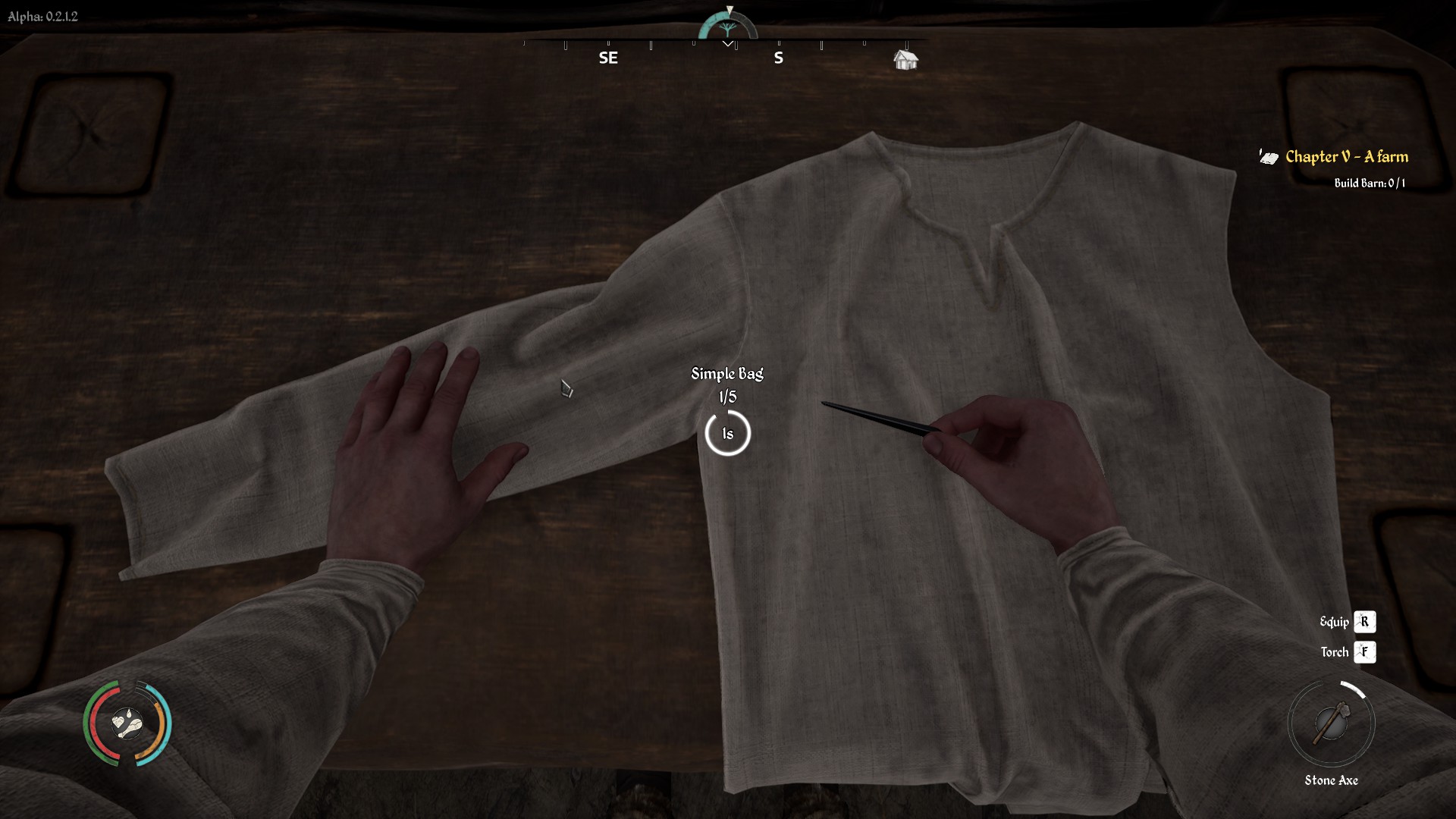
I was pleasantly surprised by Medieval Dynasty’s building system. As opposed to that of Empires and Tribes, which I previewed recently, the hammer tool lets you see exactly which parts of the building need which resources, and adding those resources is as intuitive as having them in your inventory when you hit it. Of course, this is because Dynasty doesn’t let you designate villagers (when you have them) as builders. It would be a little more convenient if it did, considering how few logs you can carry at once and how many you’ll need, but given you’re unlikely to be adding more than a couple of buildings at once and you can increase your carrying capacity with bags, it perhaps isn’t too big a deal. Getting the resources in the first place and lugging them back from an ever-increasing deforestation radius over-encumbered is more of an issue. It’s easy to sympathise with one Steam poster with a lumber obsession who lamented they couldn’t float logs downriver or have some other authentic means of faster transportation.
Survive
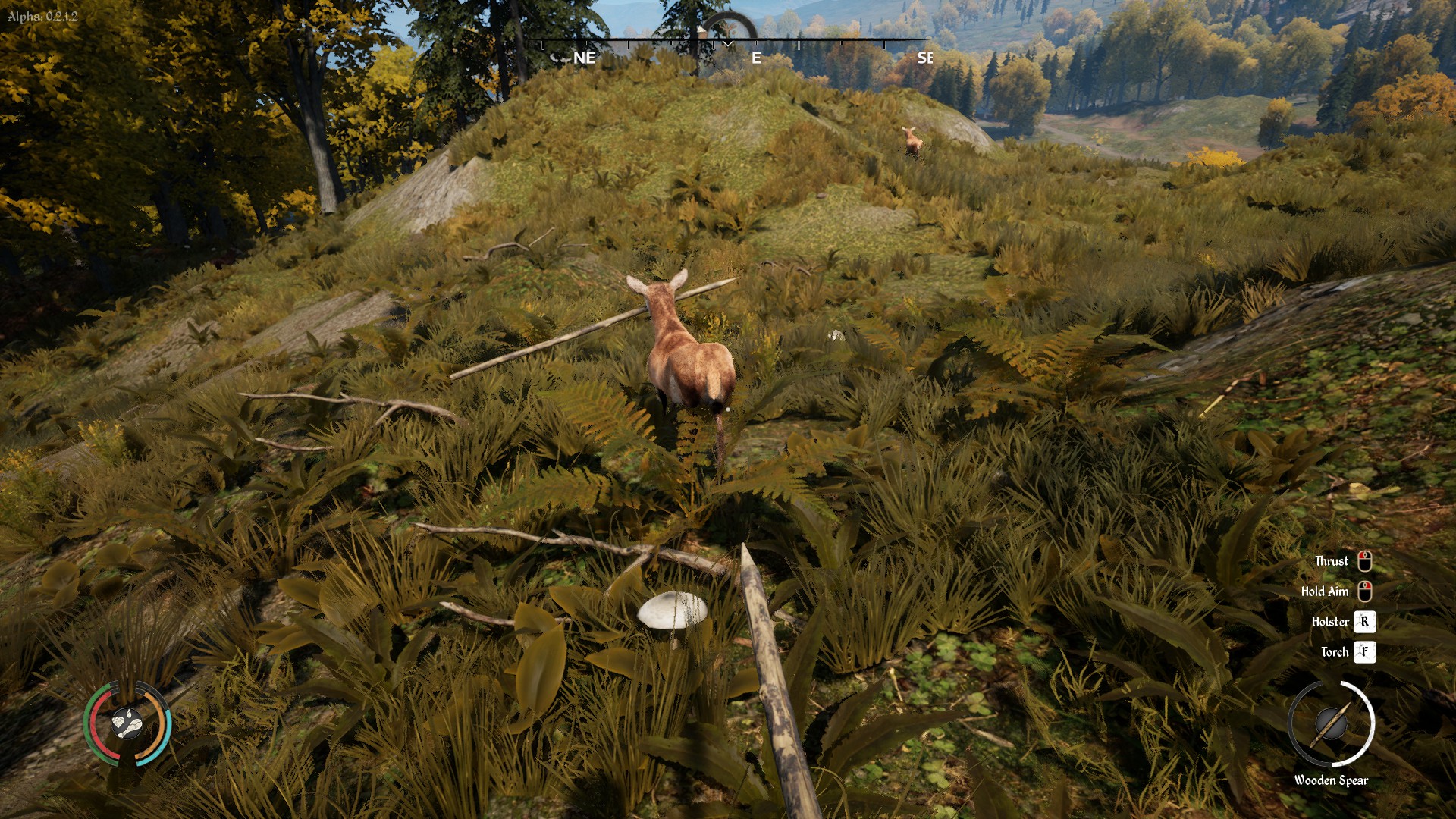
Early game, at least, the most important resources for building are sticks, reeds and logs. Sticks are easy, given they’re everywhere. Reeds are easy if annoying due to the sheer number you have to pick up. When you have a full farm established you’ll have a less annoying source of straw, but that comes pretty late into things. Logs are the main issue. They do regrow after two years (as long as you have your brain switched on, like I didn’t, and don’t dig up the stumps with a spade, as that’s not how coppicing works), but the rate at which you chew through them is a little alarming. Unless you luck out with a villager’s stats, they won’t even bring in logs fast enough to use for firewood, let alone whatever else you might want to do with it. But it’s manageable, and the sight of your little village growing on the thin strip of land you’ve found that isn’t sloped is encouraging.
Hunting isn’t all too difficult, once you get the hang of it and learn where to find the animals you’re looking for. The food from them doesn’t last long – a whole deer doesn’t fill you up as much as a hearty bowl of soup and sells for far less – but it’s not too difficult to get. It is, however, deeply unintuitive to anyone familiar with anatomy and where to stick things where they’ll die. When I hunted my first deer, I lined up the perfect shot: a spear thrown straight into the heart/lungs area. Given it hit right on target, I was surprised to see it bounce away from me at full speed. The kill zone for each animal, it seems, is its head, and even then it can take a few hits to bring it down. Injuries never slow the animal, so that extra level of realism is lost as well. Nowhere is this disconnect more egregious than with wisent, which are European bison with nice thick skulls to protect them. Thankfully, the AI is ‘good’ enough that they sometimes stand still for you to shoot repeatedly.
I will say that there is nice variety in the animals you can hunt and their temperaments. Attack a wisent and it will charge. Attack a deer and it runs away. Attack a fox and it’ll bite your ankles until you die if you only have a knife and forget to crouch, because it’s small and angry and you apparently can’t punt it across the map with a boot*.
Multiply
![A woman stands in an inn. She is replying to a flirtatious boast of killing a bear with, 'Oh, you did? What kind of approach have you taken? Bears are quite dangerous. I like sneaking up on them to get a few shoots [sic] in before they start attacking.'](https://s3-b3bucket.s3.eu-west-2.amazonaws.com/wp-content/uploads/2020/12/16182255/20201201201002_1.jpg)
The next generation demanded she set down her axe, however. Anyone giving birth has their job set to ‘mother’, which lasts as long as it takes for the child to grow. That child is your security. If you die, you live on in them, and they inherit all your stats to boot.
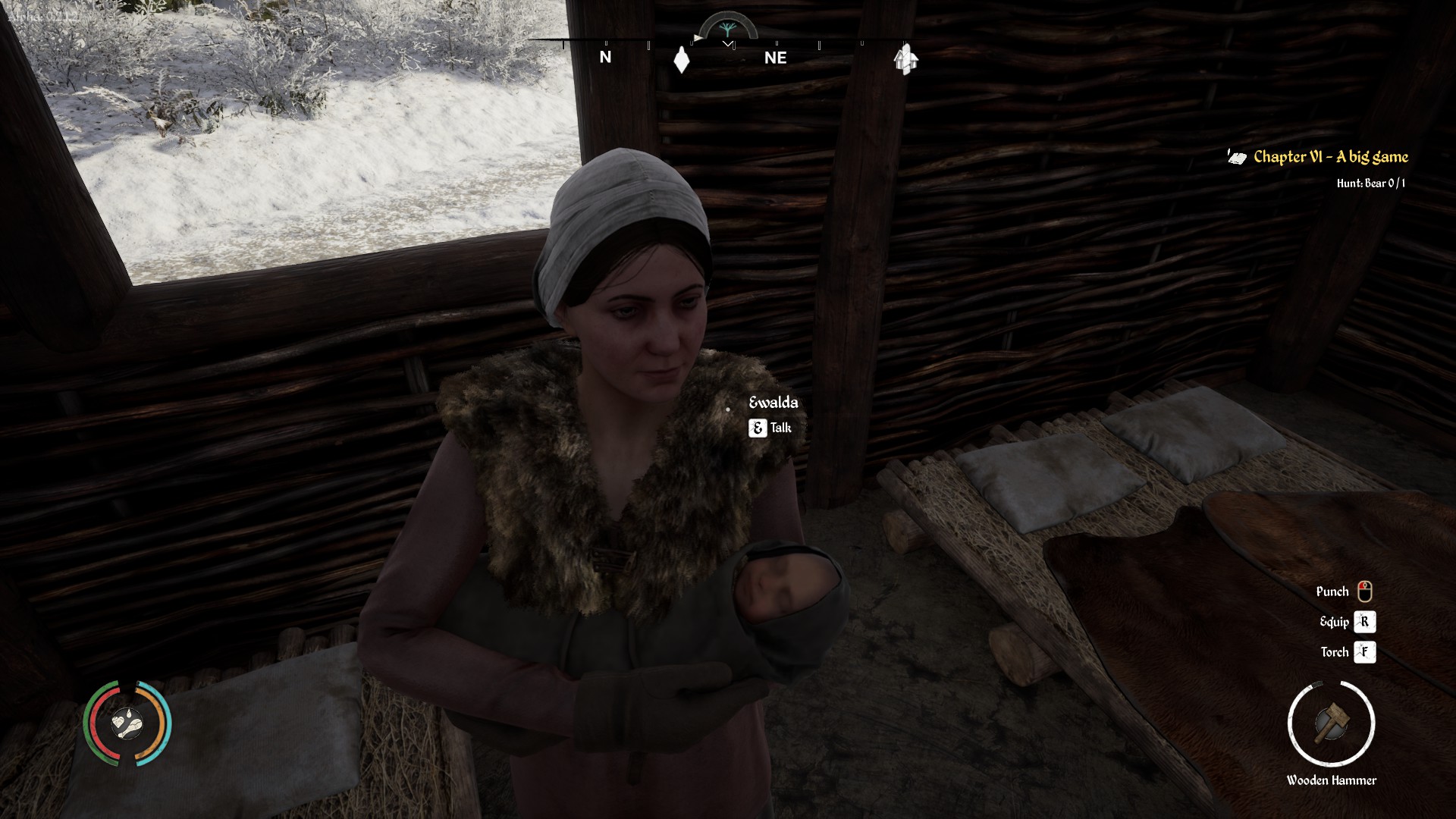
Recruiting villagers to help you (especially if your wife is occupied elsewhere) works along similar lines. You talk the villager’s ear off until they like you enough to want to move in, then you make sure to assign them a house and provide them with food and firewood. It’s not the most thrilling task. Conversation topics cycle through in rapid succession, so you end up repeating the same chatter for the same villager, let alone multiple people, and you risk offending them if you pick the wrong option by mistake. Going for the British standard of ‘Isn’t the weather nice today?’ earns you revulsion in the throes of winter.
Once you have the hang of it, it’s not too difficult, and it becomes easy enough to convince more people to stay. Each has a different skillset and will be better at different jobs. There’s a management screen to assign jobs and houses, which is quite hidden away. Once we’d built the extra house for our first new villager, we had to go away and find it to assign the house to them, and even then we missed a lot of the sub-menus we’d need to manage workplace output later on. It’s such a useful set of menus that it definitely deserves its own tutorial note to help you find it.
Manage your assets

A fresh supply of workers means you can start dishing out chores. Most important of these to begin with is the hunting lodge. Assign someone as a hunter and you’ll never need to hunt again as long as you don’t go too far from home. You can change the exact percentage of resources your workers go after using tabs on the building in question from the management screen. For the hunter’s lodge, you can adjust whether you’d prefer them to focus on meat, feathers, fur or leather, as well as resources obtained via gathering, which is assigned as a separate job. There’s a similar split for a woodshed: logs, sticks, firewood and planks. As mentioned, collecting logs alone is quite slow and making firewood is painfully so. You’re better off chopping any logs they collect yourself, for the time being.
It’s when you branch into farming that management starts to earn its name. For every field you own, you can designate exactly where you’d like your workers to plants crops. The workers are a little slow starting, so with small fields it’s faster to do them yourself (and builds up more experience for unlocks), but they do work the fields. The main issue is the sheer cost of getting farming started. Seeds and fertiliser are so expensive that building up a good collection is a very gradual process. This is bizarre for fertiliser in particular considering how many animals there are and their universal need to poop. While you can accumulate seeds with time, the more you harvest, fertiliser remains the limiting factor and is a major money sink.
Cement your place in the world
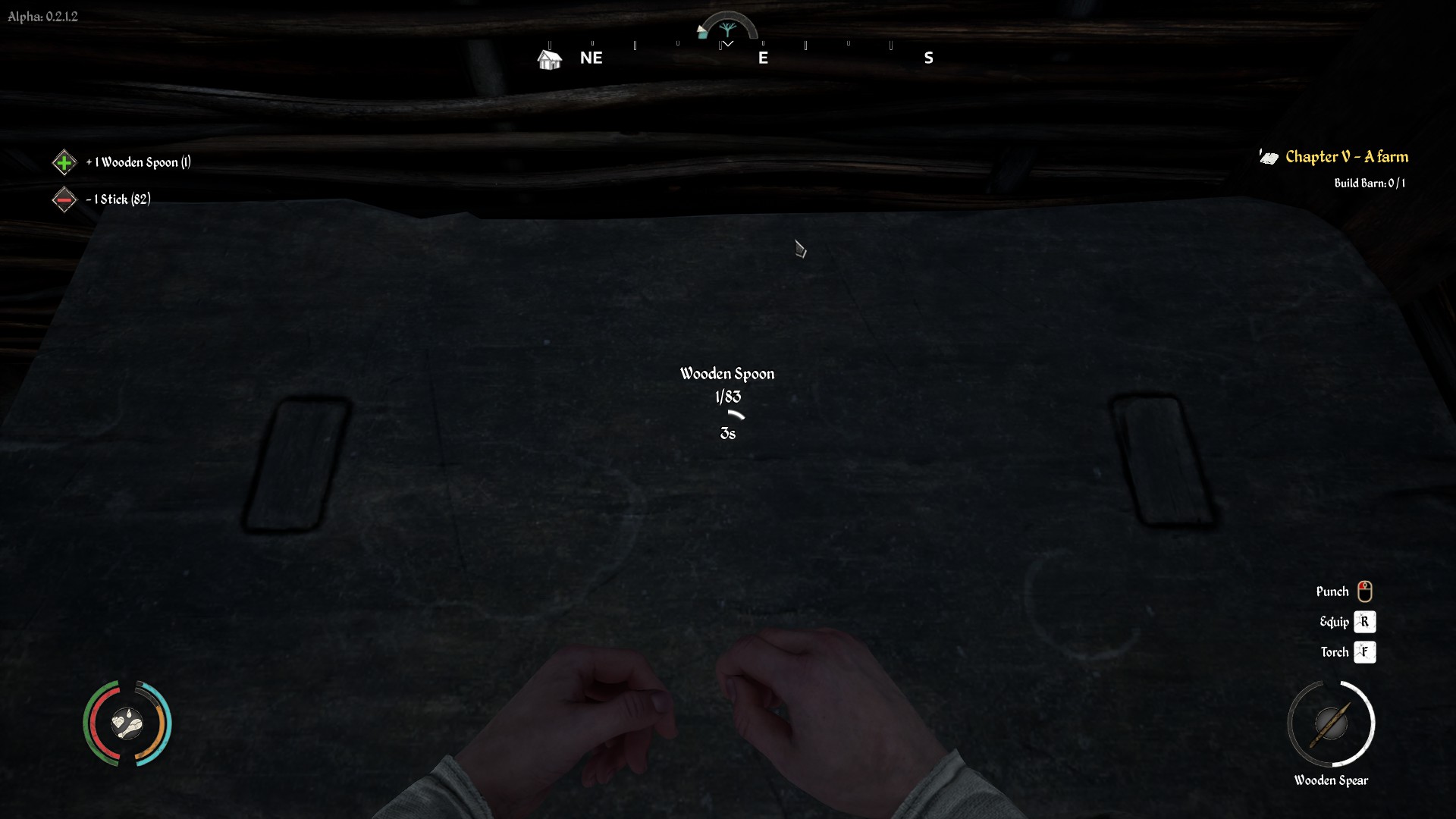
While we’re talking about money, we should mention how bizarre its balancing feels at the moment. Because all your produce is marked down when selling it (a markdown you can reduce much later in the game with a high-tier perk), making a hundred wooden spoons out of a hundred sticks nets exactly the same profit as selling the sticks outright. Many items you can create actually sell for a loss. While such markdowns are common for roleplaying games, it is absolutely not representative of what an inter-settlement economy should be. A rough equivalency in produce would make it feel a lot more like a barter economy and less like everyone’s out to rob you. And if they did introduce a barter economy it would be a natural next step to barter for supply lines. Not every village can be built next to a quarry, or perhaps you just don’t want to set up that far away. Why can’t you just trade your village’s resources freely with another to get those rocks sent your way?
What we’ve seen of Medieval Dynasty’s economy so far is, to put it bluntly, a shambles. It just doesn’t work. Sure, you can grind your way past it, but it would be good to see prices reflect the time that goes into crafting items.
Not that I’m salty about crafting a hundred and eighty spoons for nine minutes straight before realising the sale price.
Grow your skills

Some hardships do become a little easier with time. You level up skills as you use them, which lets you choose from a set of perks for each skill. These can do things like increase your carry weight, make tools last longer and make buying prices cheaper, though they tend to be small and cumulative rather than anything immediately noticeable. More importantly, levelling your skills and increasing your dynasty’s reputation (through completing quests) unlocks more useful buildings. It feels like they take forever to unlock in the beginning (especially the hunting lodge, which you level up for by hunting animals), but as you get more to do later in the game, this becomes less of an issue.
The skills that govern building unlocks are more accurately technologies, which are a separate set of trees related to all the work/building types you can get. Every time you unlock a new building in one of these technology paths, you unlock a set of crafting recipes to go with them.
Except… you don’t really unlock them. You have to pay an often hefty fee for each recipe you want to be able to use. If there is one thing Medieval Dynasty does not need, it’s another money sink. It might make sense for things like traps and clothes, which would need plans and patterns respectively, but five hundred silver for a wooden fence is a bit steep and paying for potage recipes at all is odd considering potage is just ‘whatever food you happen to have, cooked in a pot’.
Conclusion
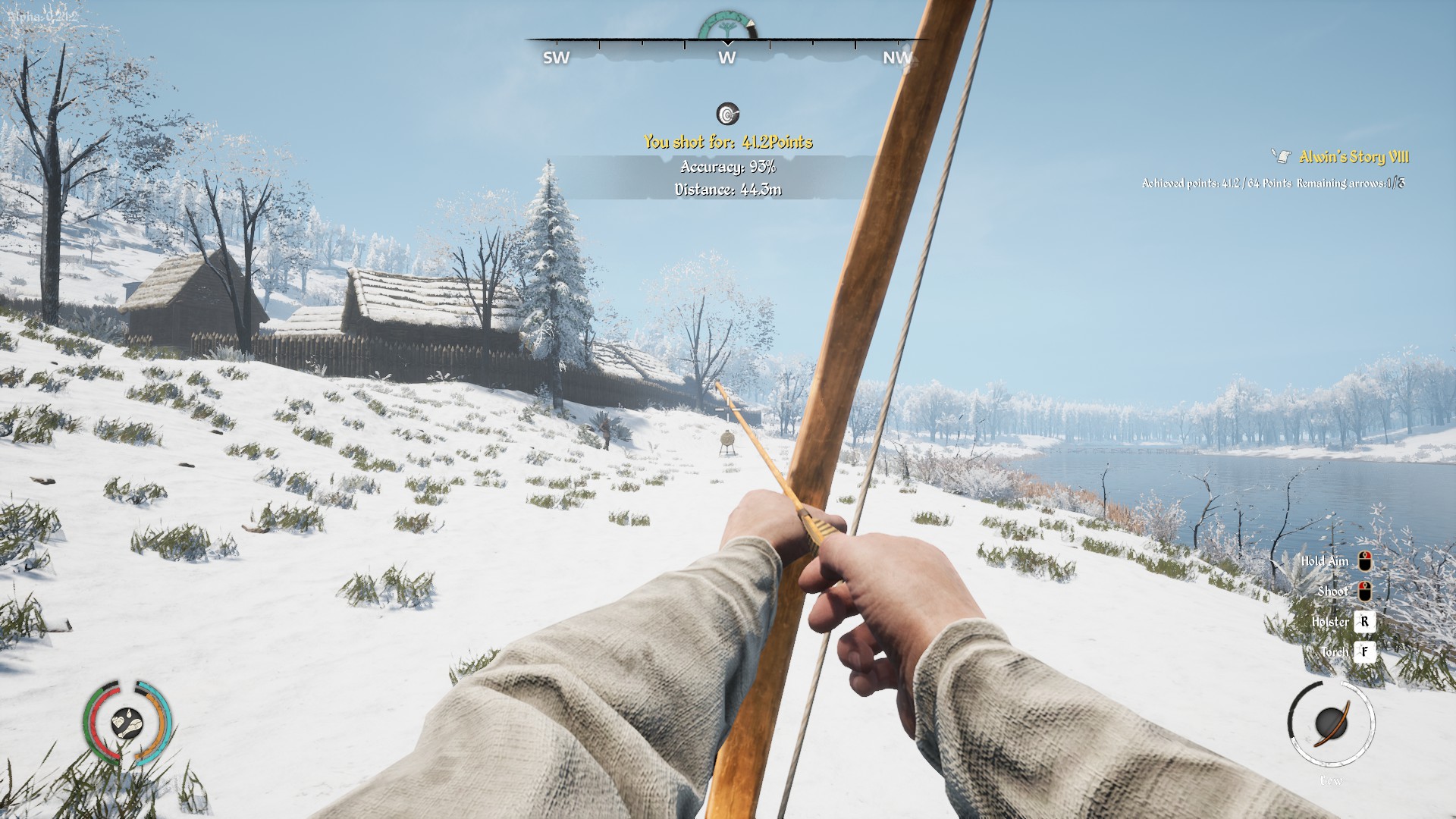
Perhaps the best analogy I have is borrowed from my husband: Medieval Dynasty feels like someone wanted to take the town-building section of Kingdom Come: Deliverance and make it a standalone game. Ever more cynical than I, he pointed out the suspicious similarity of the inventory screens, but if you’re being more forgiving, there are only so many ways to make a UI seem medieval. The real problem is that it tries to do too much, and it falls short of the mark in the process. With four genre ingredients to juggle, survival comes out on top, leaving the simulation aspect of crafting and building floundering at the bottom.
So I have mixed feelings about Medieval Dynasty. On the one hand, it looks beautiful, it has solid mechanics and it has a lot of exciting new features in its future. I’ve enjoyed playing it, if I’ve found it frustrating. On the other hand, it needs some tender loving care when it comes to making sense. It’s definitely a game to watch if survival and building are your things. Even so, I come back to one of the first points I mentioned and the one I believe most urgently needs to be addressed for building to be anywhere near its full potential: we need to be able to build on hills.
*We do not advocate punting foxes anywhere. Please be nice to the little fluffies.
Comments are closed.